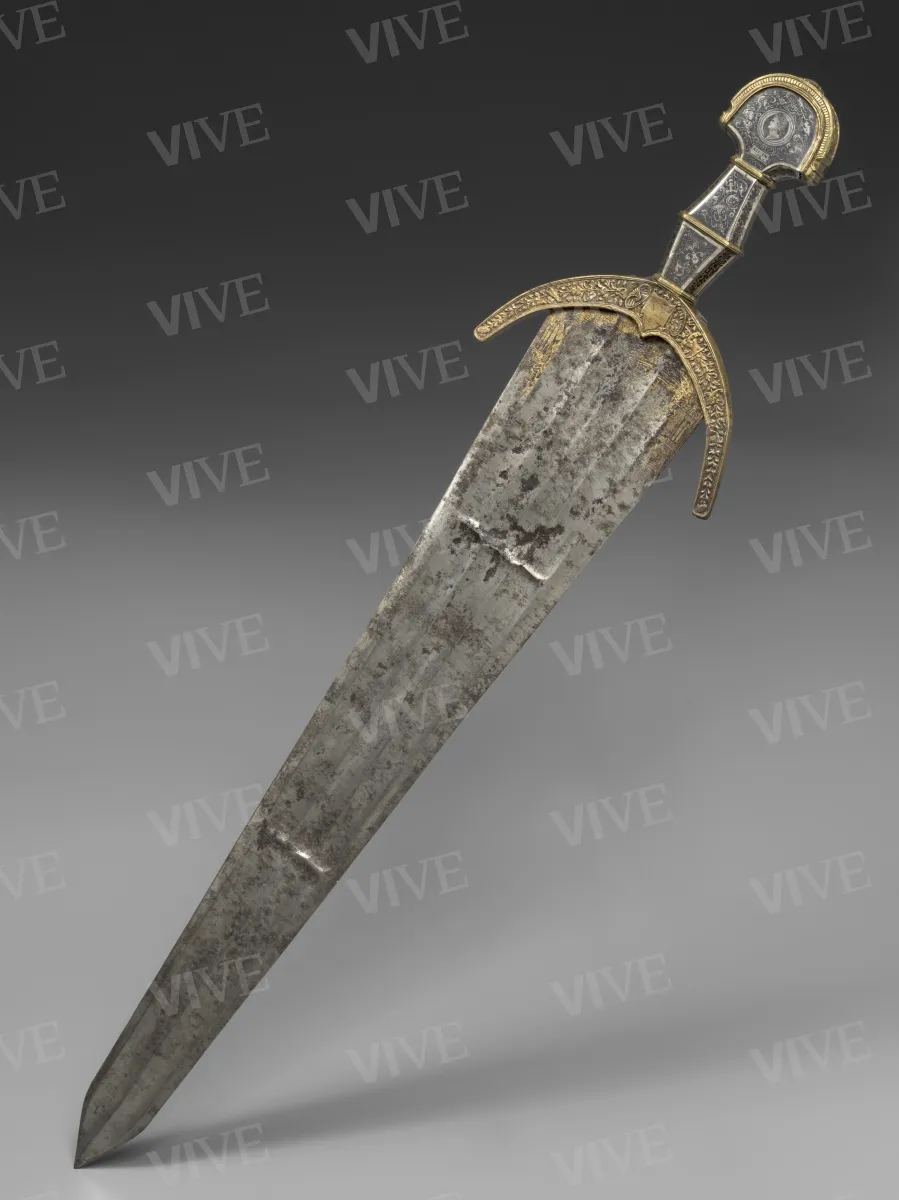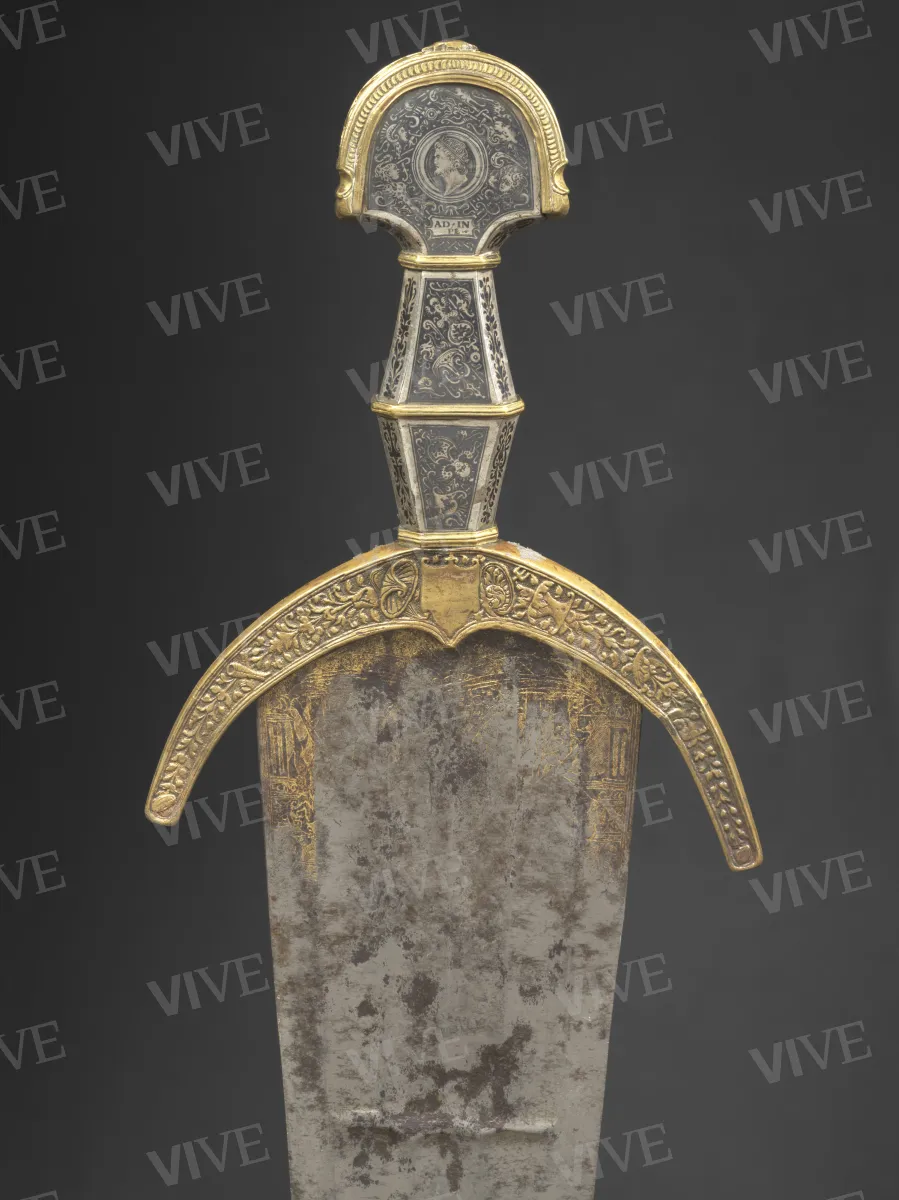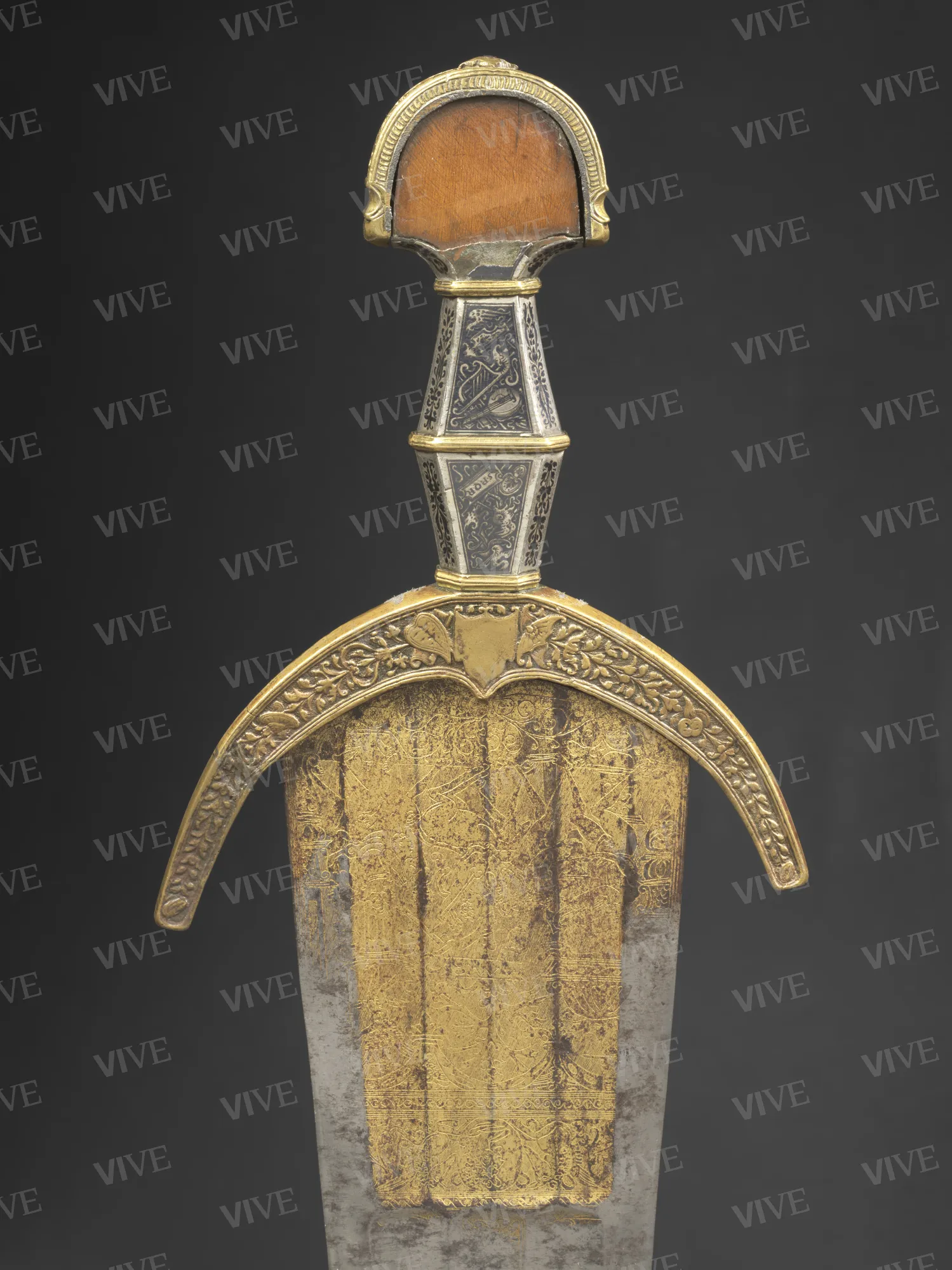Cinquedea
Emilian production 1490–1510
The cinquedea, a short, pointed sword, also known as an ox-tongue dagger, was popular among the Italian upper classes. Made in Emilia around the late fifteenth to early sixteenth century, this example features engravings and gilding on the blade. It was bought by Ladislao Odescalchi from the French market in 1902.
The cinquedea, a short, pointed sword, also known as an ox-tongue dagger, was popular among the Italian upper classes. Made in Emilia around the late fifteenth to early sixteenth century, this example features engravings and gilding on the blade. It was bought by Ladislao Odescalchi from the French market in 1902.
Details of work
Catalog entry
The cinquedea features a tongue-shaped blade divided into three sections with grooves and adorned with engravings and gilding on both sides. On one side, there are plant motifs, an emperor’s head within a clypeus, and winged horses. The other side, which is damaged due to the loss of gilding, depicts human figures. The hilt includes a chiseled and gilded metal pommel with curved branches, decorated with plant motifs, shields, masks, and an empty coat of arms in the centre. The handle comprises a wooden core with niello silver plates (one of which is missing) that alternate trophies of weapons with helmets, and in the pommel, they display a clypeus with the crowned head of the Roman emperor Hadrian, complemented by a tabula ansata bearing his name (di Carpegna 1976, p. 50; di Carpegna 1969, p. 50, n. 286). Some scholars believe that this hilt may be a nineteenth-century reproduction (Schedelmann 1965, p. 125).
This short sword is known as a dagger, dagger-like sword, ox-tongue sword, or cinquedea, due to the blade's width of approximately five fingers. It derives its shape from the Roman parazonium and became prevalent in the fifteenth century in the Veneto and Adriatic regions. The grooves, or fullers, along the blade were designed to make it lighter and more manageable for delivering deep, lethal blows. In Bologna and Ferrara, where records of weapons makers' workshops exist, these weapons are consistently referred to as “daggers” (Righini 2020).
This cinquedea bears the maker’s mark on the blade, identical to those found on at least three similar swords in the Wallace Collection in London (inv. A741, A743, A745). While the maker's mark alone may not be sufficient to assign the sword to a particular context, the blade's decorations are reminiscent of the workshops in Emilia that were active during the fifteenth and sixteenth centuries (Scalini 2018, p. 261, n. IX.8). Notable among these is Salomone da Sesso (active between 1487 and 1518), who signed his works as Ercole de’ Fedeli and adorned bladed weapons with intricate engravings featuring human figures in combat, antique heads, and plant motifs (Bianco 1993). Additionally, the work of the “Master of the Little Horses,” known for his predominant use of prancing horse motifs and active in Ferrara at the end of the fifteenth century, presents a striking similarity (Righini 2020, p. 27).
This weapon is part of the collection of Ladislao Odescalchi (1846–1922), which was acquired by the Italian State in 1959 and subsequently placed in Palazzo Venezia in 1969. According to preserved documents, it is known that Odescalchi purchased the cinquedea in 1902 from Parisian antiquarian Louis Bachereau—who also supplied weapons to Otto von Kienbusch, now housed in the Philadelphia Museum of Art—for a sum of 24,000 francs (di Carpegna 1994, pp. 25–26; Barberini 2007, p. 109).
Giulia Zaccariotto
Entry published on 27 March 2025
State of conservation
Good.
Coats of arms, emblems, and marks
In the center of the blade is the arms dealer’s trademark, which consists of an open "V" with four small teeth underneath.
On the hilt, within a tabula ansata under a clypeus featuring the head of an emperor, there is the inscription "AD[rianus] • IN/PE[rator]."
Provenance
Carmichael Collection;
in 1902 sold by the antiquarian Louis Bachereau to Ladislao Odescalchi (Odescalchi, no. 376);
Rome, acquired by the Italian State, 1959;
Rome, Museo Nazionale di Palazzo Venezia, 1969.
Exhibition history
Rome, Museo Nazionale di Palazzo Venezia, Antiche armi dal sec. IX al XVIII. Già Collezione Odescalchi, May–July 1969;
Rome, Museo Nazionale di Castel Sant’Angelo; Rome, Museo Nazionale di Palazzo Venezia, Armi e potere nell’Europa del Rinascimento, July 26–November 11, 2018.
References
Laking Guy F., A record of European Armour and Arms through Seven Centuries, 5 voll., London 1920-1922, III, p. 73, fig. 855;
Schedelmann Hans, Der Waffensammler. Gefälschte Prunkwaffen, in «Waffen und Kostümkunde», 1965, pp. 124-152;
di Carpegna Nolfo (a cura di), Antiche armi dal sec. IX al XVIII. Già Collezione Odescalchi, catalogo della mostra (Roma, Museo Nazionale di Palazzo Venezia, maggio-luglio 1969), con schede a firma del curatore, Roma 1969, p. 50, n. 286;
di Carpegna Nolfo, Le armi Odescalchi, Roma 1976;
Bianco Roberta, Ercole de’ Fedeli, ad vocem, in Dizionario Biografico degli Italiani, XLIII, Roma 1993;
di Carpegna Nolfo, Two Great collectors: Kienbusch and Odescalchi, in «Man at Arms, The Journal for the American Arms Collector», XVI, VI, 1994, pp. 21-26;
Barberini Maria Giulia, La collezione Odescalchi di armi antiche: storia della raccolta del principe Ladislao, in «Bollettino d’arte», s. VI, XCI, 2006 (2007), 137/138, pp. 101-114;
Fossà Bianca, Studio conservativo delle armi e armature Odescalchi. Nuove metodologie per la schedatura di una collezione, in «Bollettino d’arte», s. VI, XCI, 2006 (2007), 137/138, pp. 115-142;
Scalini Mario (a cura di), Armi e potere nell’Europa del Rinascimento, catalogo della mostra (Roma, Museo Nazionale di Castel Sant’Angelo; Roma, Museo Nazionale di Palazzo Venezia, 26 luglio-11 novembre 2018), con schede a firma del curatore, Cinisello Balsamo 2018, p. 261, n. IX.8;
Righini Massimiliano, Le cinquedee. Armi di principi, nobili e soldati, in Iotti Roberta (a cura di), Incontrando i Borgia: luoghi, persone e vicende della famiglia del Rinascimento, Modena 2020, pp. 191-212.
















